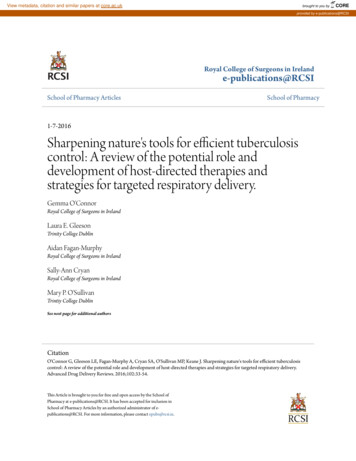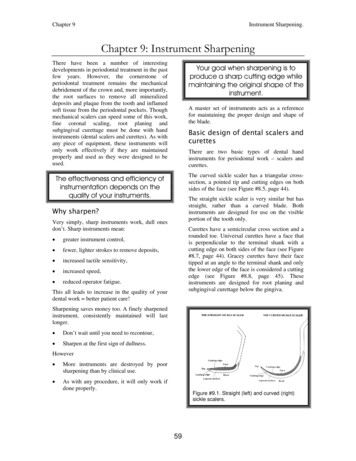
Transcription
View metadata, citation and similar papers at core.ac.ukbrought to you byCOREprovided by e-publications@RCSIRoyal College of Surgeons in Irelande-publications@RCSISchool of Pharmacy ArticlesSchool of Pharmacy1-7-2016Sharpening nature's tools for efficient tuberculosiscontrol: A review of the potential role anddevelopment of host-directed therapies andstrategies for targeted respiratory delivery.Gemma O'ConnorRoyal College of Surgeons in IrelandLaura E. GleesonTrinity College DublinAidan Fagan-MurphyRoyal College of Surgeons in IrelandSally-Ann CryanRoyal College of Surgeons in IrelandMary P. O'SullivanTrintiy College DublinSee next page for additional authorsCitationO'Connor G, Gleeson LE, Fagan-Murphy A, Cryan SA, O'Sullivan MP, Keane J. Sharpening nature's tools for efficient tuberculosiscontrol: A review of the potential role and development of host-directed therapies and strategies for targeted respiratory delivery.Advanced Drug Delivery Reviews. 2016;102:33-54.This Article is brought to you for free and open access by the School ofPharmacy at e-publications@RCSI. It has been accepted for inclusion inSchool of Pharmacy Articles by an authorized administrator of epublications@RCSI. For more information, please contact epubs@rcsi.ie.
AuthorsGemma O'Connor, Laura E. Gleeson, Aidan Fagan-Murphy, Sally-Ann Cryan, Mary P. O'Sullivan, and JosephKeaneThis article is available at e-publications@RCSI: http://epubs.rcsi.ie/spharmart/29
— Use Licence —This work is licensed under a Creative Commons Attribution-Noncommercial-Share Alike 4.0 License.This article is available at e-publications@RCSI: http://epubs.rcsi.ie/spharmart/29
Sharpening nature’s tools for efficient tuberculosis control – a review of the potential role anddevelopment of host-directed therapies and strategies for targeted respiratory delivery.Gemma O’Connor1,2, Laura E Gleeson2, Aidan Fagan-Murphy1,4, Sally-Ann Cryan1,3,4,Mary P O’Sullivan2, Joseph Keane2.1Schoolof Pharmacy, Royal College of Surgeons in Ireland, Dublin 2, Ireland; 2Trinity Centre forHealth Sciences, St James’s Hospital, Dublin 8, Ireland; 3Trinity Centre for Bioengineering, TrinityCollege Dublin, Dublin 2, Ireland; 4SFI Centre for Research in Medical Devices (CURAM).gemmaoconnor@rcsi.ie, gleesole@tcd.ie, aidanfmurphy@rcsi.ie , scryan@rcsi.ie ,mary.osullivan@tcd.ie , jkeane@stjames.ie .Corresponding author: Joseph Keane (jkeane@stjames.ie)
AbstractCenturies since it was first described tuberculosis (TB) remains a significant global public healthissue. Despite ongoing, holistic measures implemented by health authorities and a number of neworal treatments reaching the market there is still a need for an advanced, efficient TB treatment. Anadjunctive, host directed therapy designed to enhance endogenous pathways and hence complimentcurrent regimens could be the answer. Integration of drug repurposing, including synthetic andnaturally occurring compounds, with a targeted drug delivery platform is an attractive developmentoption. In order for a new anti-tubercular treatment to be produced in a timely manner, amultidisciplinary approach should be taken from the outset including stakeholders from academia, thepharmaceutical industry and regulatory bodies keeping the patient as the key focus. Pre-clinicalconsiderations for the development of a targeted host directed therapy are discussed here.Key wordsAnti-tubercular, immunomodulation, vitamin, targeted drug delivery, microparticle, particleengineering, inhalation, adjunctive therapy, in vitro, in vivo, pre-clinical testing, multidisciplinary.
Contents1. Introduction2. Host-directed therapy (HDT) for tuberculosis2.1 Vitamins as HDT2.1.1 Vitamin A2.1.2 Vitamin D2.1.3 Antioxidant vitamins2.1.4 Practicalities of vitamins as HDT2.2 Other HDTs2.2.1 Autophagy inducers2.2.2 Metabolic regulators2.2.3 Eicosanoid manipulation2.2.4 Corticosteroids2.2.5 Cytokine modulation2.2.6 Protein kinase inhibitors2.2.7 Matrix metalloproteinase inhibitors2.2.8 MicroRNA’s (miRs)3. Potential advanced formulations for targeted, respiratory delivery of HDT3.1 Formulation experience with HDT in clinical and non-clinical settings3.2 Inhalation devices for HDT3.3 Particle properties and their influence on the effectiveness of inhaled therapies3.4 Particle engineering approaches3.4.1 Microparticle-based drug delivery systems3.4.2 Lipid-based drug delivery systems3.4.3 Alternative particle engineering strategies4. Pre-clinical efficacy models specific to HDT4.1 Mycobacterium tuberculosis (Mtb) strain selection4.2 In vitro models of Mycobacterial infection4.2.1 Macrophages4.2.2 Dendritic cells4.2.3 Airway epithelial cells4.2.4 Neutrophils4.2.5 3-D models of Mtb infection4.3 6 Testing HDTs in combination with conventional anti-tubercular drugs4.3 In vivo models of mycobacterial infection4.3.1 In vivo model selection4.3.2 In vivo models suitable for HDT screening in Mtb infection4.3.3 Obtaining and interpretation of results following HDT treatment5. Concluding remarks6. References
1. IntroductionTuberculosis (TB) infection, caused by the pathogen Mycobacterium tuberculosis (Mtb), represents aglobal public health crisis traversing centuries. Recent figures published by the World HealthOrganisation (WHO) cite TB as the leading cause of death by infection alongside HumanImmunodeficiency Virus (HIV), responsible for 1.5 million deaths annually [1, 2] . Compounding thiscrisis is the rising number of drug resistant cases of Mtb infection. Multi-drug resistant TB (MDRTB),defined as resistance to at least the two first-line anti-bacterials (isoniazid and rifampicin) andextensively drug resistant Mtb (XDR-TB), characterised by additional resistance to second-linetherapeutics, have complicated the already arduous treatment regimens [3]. Despite reductions in theglobal burden of TB following the WHO’s introduction of directly observed treatment, short-course(DOTS) in the 1990s, and recently the adoption of a more holistic approach by incorporating patientcare, policy and research, the stated aim of reducing TB deaths and incidence by 90% and 80%,respectively, between 2015 and 2030 remains a substantial challenge [1, 4]. The TB Alliance,established in 2000, has placed significant emphasis on the development of new combinatoryregimens, and crucially, new drug candidates, by bringing organisations together using its productdevelopment partnership approach (PDP) [5]. Two new drugs, delamanid and bedaquiline, haverecently been licensed for the treatment of MDR-TB. However, as with conventional antimycobacterials, acquired resistance to these novel agents has already been reported, emphasisingthe limitation of pathogen-directed therapies in treating this heterogeneous and dynamic disease [6].Our natural defences, however, should not be underestimated. Despite one third of the world’spopulation living with latent tuberculosis infection (LTBI), just 9.6 million people developed activedisease in 2014 [1]. The host immune response to TB infection, therefore, is capable of successfullylimiting infection in the majority of individuals. Thus, a logical question is how can the immuneresponse be enhanced in patients where active disease takes hold? The concept of ‘host directedtherapies’ (HDT), whereby therapeutics targeting the human host’s immune response to infection forthe purpose of augmenting beneficial and reducing harmful features, have garnered significantinternational interest, evidenced by the recent publication of several high-quality reviews on the topic[7-9]. The most obvious attraction of this approach is the lower likelihood of development of treatmentresistant strains of Mtb in comparison to conventional pathogen-directed therapies. Additionally, HDTshold potential in a myriad of settings – as vaccine adjuncts, as prophylactic therapies for close
contacts of cases, as strategies to limit infectivity and shorten treatment duration, as well as improvingoverall survival outcome and reducing the lung tissue damage resulting from excessive inflammation.Furthermore, “drug repurposing” of currently licensed medications has already been highlighted as anapproach to tackling the TB pandemic, given the benefits of faster market access and reduceddevelopment costs [10, 11].Several drugs currently licensed for other indications (some of which arealso off-patent) are showing promise as potential HDTs, offering affordable provision to theunderdeveloped economies that most require novel TB therapies.The host immune response to Mtb infection, however, is layered with complexity. Many immunefunctions that are vital early in host defence prove detrimental in advanced infection [12].Consequently, in addition to agents that enhance the natural host immune response to TB, a largenumber of anti-inflammatory agents that work through attenuation of the destructive effects ofexcessive immune responses are also under investigation as potential HDTs. The temporal events ofinfection and disease progression must be understood and considered in order to maximise efficacyof new therapies and, crucially, to prevent undesired harmful outcomes. Additionally, severalpromising HDTs – including vitamins which are discussed in detail in this review – have beendemonstrated to influence host metabolism, therefore variable host nutritional status may beimportant in determining the efficacy of various approaches to manipulation of immune response.Genetic variations in host immunity are also likely to impact individual response to HDT to a fargreater extent than conventional pathogen-targeted antimicrobials [13], potentially suggesting a rolefor integration of pharmacogenomics and a “personalised medicine” approach into the development ofHDTs, tailoring therapies to an individual’s “immune signature” [14, 15]. Although such measures atpresent are still considered novel and consequently costly for the treatment, accompanyingdiagnostics and multidisciplinary care, if governments and policy makers truly wish to overcome thispandemic then the potential of this approach must be evaluated [15]. These adjunctive therapieswould need rationalisation in order to be efficaciously integrated into standard regimens and with that,provisions for accessibility, bearing in mind that if successful this approach could save money in thelong term freeing up resources for alternative needs.In parallel with the rise in interest in HDT and drug repurposing has been the ongoing interest inalternative methods of drug delivery in tuberculosis treatment. The use of advanced engineering andformulation tools to allow targeted delivery of anti-tubercular drugs via the pulmonary route has been
the focus of many studies worldwide using carriers designed to target the alveolar macrophage [1624]. Our group has showed that Poly(Lactide -co-Glycolide) (PLGA) microparticles encapsulatingstandard anti-tubercular drugs can be efficiently taken up by THP-1 derived macrophages and causebacillary killing in an in vitro infection model of tuberculosis [25]. Numerous crucial factors must betaken into consideration when developing an inhaled treatment ranging from the physico-chemicalproperties of formulation to device compatibility in order to ensure the formulation efficiently reachesthe site of action. Various methods of formulation manufacture will be discussed later in this review,meanwhile device design technology for pulmonary delivery of treatments in chronic conditions suchas cystic fibrosis continues to advance, particularly in the administration of labile proteins, an aspectwhich may prove crucial in the development of HDT for TB [26].It is clear, therefore, that a true multidisciplinary approach must be taken to enable the developmentof new anti-tubercular treatments. If a novel cargo can be combined with more efficient, targeted drugdelivery a number of attractive opportunities could develop [8]. Figure 1 shows a number of the keystakeholders required in the process of HDT drug development: clinicians for first-hand experienceand patient interaction, research scientists including immunologists, microbiologists, geneticists,pharmaceutical scientists, chemists, and bioengineers for idea generation and preclinical testing.Once collected, the data can be disseminated to industry for manufacture scale-up, device design andclinical trials with the aim of securing a marketing authorisation). A substantial amount of time willpass before any new treatment can be brought before policy makers, integrated into protocols andeventually reaching the patient. A new chemical entity (NCE) can take 10 – 20 years to reach themarket under the U.S Food and Drug Administration (FDA) regulations, a timeline that the TBcommunity cannot afford therefore with the use of repurposed drugs, including HDT’s, could be theanswer.
Fig.1. Multidisciplinary commitment is required for host-directed drug development. Thepatient must be the focus of all development strategies.In this review, we discuss a number of the multidisciplinary aspects important in the pre-clinicaldevelopment of HDT, including drug selection and delivery as well as design of both in vitro and invivo models for evaluation of efficacy. With a primary focus on vitamins as HDTs, we discuss the codevelopment of potential pulmonary delivery systems for an efficient new therapy for Mtb infection2.0 Host-directed therapies (HDT) for TuberculosisMycobacterium tuberculosis (Mtb) has a tendency to reside in oxygen rich tissues of the lungs whereit is phagocytosed by alveolar macrophages (AM) and readily manipulates the host environment for itsown gain. Inflammation and granuloma formation follows infection allowing containment of thebacteria, however, a fine balance of this immune response is required to limit dissemination anddevelopment of active disease whilst simultaneously maintaining lung structure and function [9, 27].HDT for Mtb infection include a wide range of compounds targeting a plethora of different (sometimesopposing) pathways, reflecting the intricacy of the human immune response to the bacillus. When
discussing possible compounds, whether for targeted, pulmonary delivery or otherwise, it is importantto consider the following points:1. TB necessitates the administration of multiple anti-bacterials simultaneously in order to rapidlyreduce bacterial burden and, in some cases, treat extra-pulmonary sites of infection [28-30].Therefore any new formulation developed is likely to be an adjunctive therapy to currentregimens.2. With the aid of appropriate diagnosis, current regimens for TB are generally effective with atreatment success rate of 86% for all newly diagnosed cases in 2013 [1]. The greatest threatto this statistic is MDR-TB and so a therapy aimed at treating or preventing the escalation ofMDR-TB by, for example shortening current regimens, would be most beneficial [30].3. The active ingredient(s) should not cause serious interactions with current effectivetreatments or produce undesirable effects that would lead to further non-compliance.4. The chosen HDT should be cost effective and readily available - 95% of TB-related deathshappen in low to middle income countries therefore the cost of the treatment and formulationmust not be prohibitive[1]. A fact that might encourage investment from multinationalpharmaceutical companies.5. Due to the complex nature of the immune response to infection, it is important that we have acomprehensive understanding of the mechanism of action of any HDT in order to ensure thatwe tailor clinical trial design accordingly to avoid underestimating efficacy.With this in mind, we discuss some promising approaches to HDT for TB infection.2.1 Vitamins as host-directed therapiesEpidemiological data has shown that body mass index (BMI), and hence nutritional status, effects thehost response to TB [31]. With 95% of TB cases worldwide occurring in low to middle-incomecountries, the WHO have guidelines in place to support undernourished patients of all agesthroughout treatment with standard regimens including the prescribing of nutrient-rich foods whererequired [32]. In addition to the observed link between micro- and macro-nutritional status and TB isthe relationship between worsening lung function and vitamin C and D deficiency in smokers [33, 34].This may provide partial explanation for the epidemiological finding that smoking is a major risk factor
for TB infection, associated with an inappropriate immune response [35]. Prior to the development ofantibacterial agents, micro-nutrients such as vitamin A and vitamin D were administered to patients inthe form of cod liver oil as ‘anti-infective’ therapies for numerous conditions, including TB. Althoughlittle was known of the mode of action, these micro-nutrients were thought to enhance the immunesystem and, thereby helping to fight infection [36, 37]. Interest in nutrients subsequently waned withthe introduction of specific anti-tubercular drugs. However, the rise in resistance patterns seen inrecent decades has resulted in renewed attention being directed towards these alternativechemotherapies. Here, we review the evidence regarding the use of several key vitamins as HDT forTB.2.1.1 Vitamin AVitamin A is a fat soluble vitamin currently licenced in the treatment of acute promyelocytic leukaemia(APL) and acne vulgaris [38]. With food as the source, vitamin A can enter the body as all-transretinol, β-carotene or retinyl esters and undergoes a series of reactions before being converted to theactive metabolite all-trans-Retinoic Acid (atRA) [39]. AtRA then exerts its effect through binding to thenuclear receptor family retinoic acid receptor (RAR) which in turn heterodimerises with retinoid Xreceptor (RXR) [39]. In 1989, Crowle et al examined the effects of atRA on virulent Mtb survival invitro with cultured human macrophages treated both before and after Mtb infection. Successfulreduction in bacterial viability up to 7 days was evident in both instances, with treatment post-infectionexhibiting the greatest effect [36]. Other studies have shown anti-bacterial effects on mycobacteria inculture, indicating both pathogen-targeted and host-targeted effects [40, 41]. Anti-bacterial propertiesof atRA in vivo have been demonstrated in Mtb infected Wister-Lewis rats alongside promisinghistopathology results [42].More recently, detailed studies on the immunomodulatory and host-directed actions of atRA havebeen conducted, including investigation of its influence on the induction of phagocytosis of Mtb andautophagy [43]. This is likely due to effect on the down-regulation of tryptophan-aspartate containingcoat (TACO) protein gene transcription, allowing intracellular motility and thus phagosome-lysosomefusion to proceed, resulting in the eventual degradation of Mtb [44-46] . Cholesterol has beenhighlighted as an essential amenity for Mtb within activated alveolar macrophages, providing energyto enable the persistence of the pathogen [47]. A recent study has revealed that atRA can reducecellular cholesterol levels, thus increasing lysosomal acidification via the Niemann-Pick Disease Type
2C (NPC2) gene and leading, at least in part, to enhanced degradation of the bacillus [48].Furthermore, atRA is thought to play a part in controlling iron metabolism, another essential nutrientfor Mtb survival [49, 50]. Our group has demonstrated the effect of alveolar macrophage derived atRAon the stimulation of regulatory T Cells (Tregs) in the lungs through the transcription factor FoxP3 inconjunction with TGF-β1, leading to downregulation of the pro-inflammatory effects of the innateimmune system and upregulation of anti-inflammatory proteins – namely interleukin-10 (IL-10) [51].Although Toll-Like Receptor 2 (TLR2) is required for the balance between apoptosis and necrosisduring Mtb infection [52], atRA has been shown to down regulate TLR2 signalling and dampening ofTNF-α, IL-1RA, IL-6, IL-8, IL-10 leading to a reduction of inflammation in other disease models(Propionibacterium acnes) [53, 54]. This immune regulation by atRA could make it an ideal adjunct inthe treatment of Mtb to reduce unwanted tissue damage if administered at the correct stage ofdisease. AtRA is relatively cheap and readily available, allowing accessibility for formulation andmanufacture scale-up.Recognised for its effects on growth and differentiation as well as apoptosis, atRA treatment hasproven efficacy in a variety of clinical settings, currently licensed for use for both dermatologic andoncologic indications as previously mentioned [55, 56]. Massaro and Massaro further demonstratedthe diversity of atRA treatment by demonstrating its ability to induce alveolar regeneration in a modelof experimentally-induced emphysema [57]. Estrella et al have also shown atRA, in combination withvitamin D, to stimulate the formation of multinucleated giant cells (MNGC) [43]. The vitamin pretreatment resulted in significantly decreased bacterial viability compared to phorbol-12-myristate-13acetate (PMA) differentiated THP-1 cells and increased survival of infected MNGC lasting for 60dayspost-infection [43]. MNGC’s are a component of TB granuloma formation and although debatesurrounds the specific role of MNGC’s in the granuloma process [58, 59] the structure supports thecontainment of mycobacteria after infection [60, 61]. As well as anti-bacterial effects associated withatRA (data not shown), we have demonstrated the formation of MNGCs when THP-1 derivedmacrophages are treated with atRA post-infection (see Fig. 2). Thus, it would be reasonable topostulate that the use of atRA as a HDT for TB would possibly provide a host-protective effect byaiding granuloma formation through promotion of MNGCs and reduction in cholesterol-laden (foamy)macrophage formation as well as modulation of the inflammatory response.
Figure 2. All-trans-Retinoic-acid treated THP-1 derived macrophages leads to the developmentof multinucleated giant cells (MNGC). THP-1 cells differentiated into macrophages (using PMA)were treated with atRA in the presence or absence of Mtb infection (H37Ra) and viewed 72hours later using an Olympus IX51 microscope. Phalloidin-FITC (green) and Hoechst (blue)were added to allow visualisation of the cell actin and nucleus respectively.Despite this evidence suggesting atRA as a promising adjunctive therapy for Mtb infection, results ofpre-clinical trials have not been reflected in the clinic. Studies have found that Vitamin Asupplementation had no effect on tuberculosis outcomes, with and without co-morbidities such as HIVand diabetes [62, 63]. These outcomes could be due in part to the complex metabolism of vitamin A,depending on what form it enters the body or the stage of infection. AtRA-associated toxicities arewell documented from teratogenic effects to liver and dermatologic events [55] therefore targeteddelivery of the active metabolite could potentially overcome both issues leading to a more effectivetreatment.
2.1.2 Vitamin DVitamin D is an endogenous vitamin requiring sunlight for activation currently licenced for treatment ofosteoporosis and, in topical form, treatment of psoriasis [64]. Once metabolised from 7dehydrocholesterol to 25-dihydroxyvitamin D3 and subsequently to 1,25-dihydroxyvitamin D3 (1,25D),the fat soluble vitamin acts on the vitamin D receptor, heterodimerizing with the same nuclear retinoidX receptor family as atRA, which is often studied in parallel [39]. Anti-mycobacterial action has beendocumented since the 1980s, with slowed intracellular Mtb growth demonstrated in humanmacrophages treated with 1,25D [65, 66] and in mycobacterial culture using Mycobacteria GrowthIndicator Tube (MGIT) and BACTEC culture systems [40, 41].As described above, 1,25D in combination with atRA has effects on differentiation of monocytes,induction of phagocytosis and autophagy [43], as well as TACO gene transcription and consequentphagolysosomal maturation [44]. Distinct from atRA, 1,25D exerts its antimicrobial activity viacathelicidin antimicrobial peptide (CAMP), a 37-amino acid protein generated by monocytes, as wellas other immune cells [67]. CAMP creates pores in cell membranes rendering the bacteriasusceptible to degradation [68]. Liu et al demonstrate that this process relies upon TLR1 and TLR2stimulation to aid in the conversion of vitamin D to the active form, followed by vitamin D receptor(VDR) expression for the release of cathelicidin [69] . A transcriptomics-led study indicates a linkbetween pro-adipogenic peroxisome proliferator-activated receptor gamma (PPARɣ), VDR and lipidmetabolism, echoing the effect of atRA on nutrient availability for Mtb residing within granuloma [70].Finally, 1, 25D has host-protective properties, blocking Th1 pro-inflammatory responses andstimulating Th2 responses thus balancing cytokine release post-infection [39].With lower levels of vitamin D associated with higher mortality [71] and an increase in humancathelicidin following treatment with vitamin D3 [72] there is convincing evidence of the role of vitaminD in tuberculosis control. Nonetheless, clinical studies involving the supplementation of vitamin Dhave failed to meet expectations [73, 74] with few showing any benefit [75]. A major determinant invitamin D effectiveness is exposure to sunlight which can leading to variability across populations.Phototherapy has been used in the treatment for TB for some time. In 1903 , Niels Finsen won aNobel prize by exploiting the use of high intensity light to treat patients with various forms of TB beforea reason of its efficacy was known [76]. As overexposure to phototherapy can be dangerous andimpractical therefore a targeted form of the active vitamin D metabolite could avoid such
administration difficulties. To summarise, vitamin D boasts host protective abilities, however, itspotential in the clinic requires thorough pre-clinical and clinical investigations to determine optimaldose, treatment schedule and whether co-administration with another micronutrient such as atRAwould be more beneficial.2.1.3 Antioxidant vitaminsVitamins B, C and E as well as vitamin A are classified as antioxidants – that is, agents that preventoxidation and thus reduce cell damage caused by free radicals [39]. Obtained from various foodssources or supplementation, antioxidants have garnered interest for the treatment of TB for protectiveproperties. Although not traditionally considered as anti-bacterial or immunomodulatory agents,antioxidants have protective properties that may render them useful as HDTs.Pyridoxine (vitamin B6) has been routinely prescribed alongside isoniazid (INH) with the intention ofreducing the risk of peripheral neuropathy. This undesirable effect of INH treatment is caused by itsability to inactivate or inhibit the production of pyridoxal 5’ phosphate (active), an essential co-enzymein many metabolic reactions [77].Other antioxidants have potential in TB therapy such as vitamin C(ascorbic acid), an essential reducing agent for maintaining a healthy body, negating lipid peroxidation& decreasing genetic mutations [34]. In Mtb infection specifically, vitamin A, C and E levels aredecreased, concurrent with increased oxidative stress. Administration of these antioxidants could,therefore, reduce oxidative stress in infected patients and balance the immune response [78]. Tworecent studies depict the anti-mycobacterial role of vitamin C (i) as an anti-oxidant, through genetranscription modulation which slows growth, promoting mycobacterial dormancy [79] and (ii) as apro-oxidant via the Fenton reaction, causing an increase in ferrous ions and (as well as alteredphospholipid metabolism) damaging the bacterial DNA, an effect which is specific to Mtb and preventsdevelopment of resistance [80].Vitamin E protects against atherosclerosis but may have a role in TB treatment due to its antiinflammatory properties as it is known to reduce pro-inflammatory cytokine production IL-1, IL-6, IL-8,IFN-y and TNF-α as well as inhibit the reactive oxygen species (ROS)-driven induction of the NFκBinflammatory response [39]. The mechanism of action of vitamin E could possibly reduce tissuedamage in tuberculosis pathogenesis.
2.1.4 Practicalities of vitamins as HDTOne significant and long-recognised challenge associated with the therapeutic use of vitamins is theirinherent instability and the consequent difficulties faced in maintaining efficacy through the processesof manufacture, storage and administration. Vitamins A, C and D are susceptible to air, heat, light,moisture and pH [81], thus careful manufacturing procedures will be required for any vitamin-basedHDT. One strategy for maintenance of stability and prevention of degradation following administrationis targeted therapy through micro- (spray-drying) or Nano encapsulation, as discussed later in thisreview.Further studies are required on anti-inflammatory properties of vitamins from cytokine analysisthrough to histology post-treatment in pre-clinical models as well as lung function in clinical trials. Thiswould hopefully provide an indication of suitable dose and formulation for pulmonary delivery.None of the vitamins discussed here interact with first-line TB treatment [82]. Apart from vitamin A,which is teratogenic in pregnancy and therefore is contra-indicated, other vitamins might proveimportant in the treatment of special populations such as paediatric tuberculosis or when the patient ispregnant. Finally, vitamins are reasonably priced (depending on dose) and widely available,altogether making nature’s own tonic an attractive adjunctive therapy to Mtb infection.2.2 Other host-directed therapiesThere are a large number of other agents under investigation as potential HDTs for TB infection.Here, we discuss some of the important pathways of the host immune response that may serve aspotential targets and review those agents that are generating current interest.2.2.1 Aut
Royal College of Surgeons in Ireland e-publications@RCSI School of Pharmacy Articles School of Pharmacy 1-7-2016 Sharpening nature's tools for efficient tuberculosis control: A review of the potential role and development of host-directed therapies and strategies for targeted respiratory delivery. Gemma O'Connor Royal College of Surgeons in Ireland










